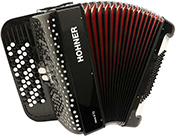Free-reed instruments produce sound by blowing air across a reed making it vibrate, however, the reed must vibrate freely, that is, not touch anything when vibrating.
There are two types of free-reed instrument:-
Unframed where the instrument has no frame to direct air to act on the reed in a consistent manner, for example as in a Jew’s Harp
Framed where the instrument has a frame creating a path for air to be directed against the reeds causing them to vibrate. Examples include accordions, melodeons and concertinas.
About accordions
There are two types of accordion, piano-key and chromatic button-key. All styles of music can be played on both. Each system offers benefits over the the other.
Piano Accordion
Easily the most recognisable type of accordion and very popular across the western world. The treble keyboard can range from 2 to 4 octaves and is arranged in same the way as a piano keyboard. Because of this familiarity, the piano accordion is considered to be the quickest and easiest for people to begin with. There is an abundance of tutor books available to guide you on good piano fingering, which is essential for the development of good playing technique and your enjoyment of the instrument. Piano accordions are well suited to many traditional styles of music which can be comfortably played on compact lightweight instruments.
To play classical repertoire, a full size 120 bass accordion with a 4 octave keyboard is recommended. Full size piano accordions are physically large and quite heavy – a disadvantage of this style of accordion.
Chromatic Button Accordion

Chromatic accordions are most popular in Europe and Russia. In Russia they are usually called “Bayans”. The treble keyboard consists of buttons arranged in a diagonal chromatic pattern. There are commonly 5 rows, rows 4 & 5 playing the same notes as rows 1 and 2 to aid fingering. There are two common systems, B system and C system which mirror each other. Opinions differ as to which is the better system. It is fair to say that if you are new to the button accordion, there is no “best” system. If you adopt and learn sensible fingering and posture from the outset, then your chosen system is the best! We would advise you try both systems to see which you find most comfortable. The compact layout of button accordions allows for a greater range of notes in smaller instrument compared to piano accordions. Since the buttons are positioned close together, large leaps and stretches are easier than on a piano accordion. This makes button accordions particularly well suited to classical repertoire.
Piano or Button Accordion? Which Should I Choose?
This is very much a personal choice and can be influenced by the type and style of music you wish to play. To help guide you, here are a few points you may wish to consider:
What are your musical aspirations? For example, do you wish to play traditional music, or is your goal to play classical repertoire?
A chromatic button accordion has a larger range of notes than a piano accordion of comparable size. This is an important difference and very relevant if you wish to play classical repertoire where the extra range will be essential.
If you are planning to take lessons, does your teacher teach your chosen type of accordion. This is particularly pertinent if you wish to learn button accordion.
There is more material, such as tutor books etc readily available for piano accordion.
Button accordions are more expensive and less common than piano accordions. This will affect the future resale potential should you wish to upgrade your accordion.
Manufacturers offer larger ranges of piano accordions than button accordions. Piano accordions are currently more widely available and offered in much greater variety than button accordions.
And Then There’s The Bass!
Played with the left hand, there are 2 distinct systems:
Stradella Bass – this is the traditional and most popular bass system. It comprises 2 rows of buttons which produce single notes with a range of 12 semitones, together with 4 rows of prefixed chord buttons. All manner of accompaniments as well as complex chords and melodies (although these may not always sound at true pitch because of the limited 12 semitone range of the single notes) can be played. Irrespective of the size of the accordion, the layout is the same.
Free-Bass – sometimes called the “classical” bass system. It has single notes with a range of several octaves allowing you to play melodies on the bass at true pitch, as you would, for example, on a 2 manual organ.
There are several different layouts similar to the chromatic button treble keyboard systems. Both piano and chromatic button accordions can be matched with either bass system. For the best of both worlds, converter bass accordions are available giving you both Free-Bass and Stradella keyboards in one instrument. At the flick of a switch, the chord buttons of the Stradella bass are “converted” into the single notes of the Free-Bass system.
The size of an accordion is described by its number of bass buttons. Sizes range from as small as 8 bass up to a full size accordion with 120 bass buttons. The larger the instrument, the greater its’ flexibility, as repertoire is not restricted by a lack of notes
48 bass accordion is an ideal beginners instrument.
72 bass instruments are a good mid range size and lightweight but may limit you’r playing.
96 bass “compact” accordions offer great scope and flexibility in a relatively lightweight package.
120 bass accordions are full size and provide the most flexibility.
Accordion Voicing
Blowing air (using the bellows) across reeds is what makes an accordion produce its sound. Each bank or set of reeds are called “voices”. Very basic accordions have one set of reeds, i.e. one voice, so only one reed will sound when you press a key on the treble keyboard. The sound or tone “colour” of the accordion is fixed. Higher specification accordions have more “voices”, up to five in fact. This means multiple reeds can sound for each note played. There are three fundamental types of voice, described in the same manner as organ pipes (in feet):-
4’ Sounds one octave higher than the note played
8’ Sounds at the pitch of the note played
16’ Sounds one octave lower then the note played
Accordions can have more than one of any voice – it is usual for there to be two, or in some cases three 8’ voices. By combining the reeds or voices in different ways, the sound of the accordion can be changed. Each sound is called a “register”. Registers are changed using switches or “couplers”. Similar to organ stops, these are switches which link the voices together in various combinations producing a selection of different sounds and tone colours.
Accordion Tuning
There are two styles of accordion tuning:-
Musette – or “wet” tuning, is where 2 or more reed sets are tuned off pitch from each other creating a vibrato effect. The strength of the vibrato or “wetness” is set by how far apart the reeds are tuned. Traditional musette tuning employs three sets of reeds, one on pitch, one tuned marginally above, the other below. To save weight, many modern accordions employ only two reed sets tuned slightly apart.
Double Octave – also called “straight tuning” employs the use of 4’ and 16’ reed to give a two octave spread, hence “double octave”. 8’ (on pitch) reeds are also incorporated into the voicing. Double octave accordions sound “dryer” than their musette counterparts, their tone resembling that of a bandoneon.
To soften the sound of the reeds and give them a warm “woodwind” feel, they can be built into a Cassotto tone chamber. Cassotto refers to one set of reeds placed in the chamber, Double Cassotto, two sets of reeds.
8’ (at pitch) and 16’ (octave below) are the reed banks normally placed “in cassotto”.


